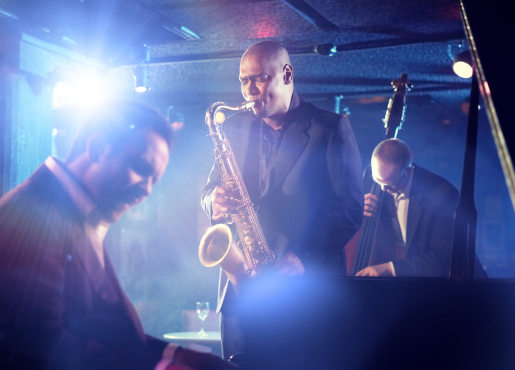
This Week on Jazz Spectrum – Gil Evans’s “La Nevada”
By Fritz Byers
The first hour of this week’s show is given over to Kim Kleinman’s artfully designed compare-and-contrast exercise, placing the orchestras of Duke Ellington and Count Basie side-by-side. Big bands were everywhere, certainly by the 1930s, and there were dozens of great ones. But the common wisdom, which just this once is correct, is that Duke’s and Count’s ensembles rose above the rest. Explicating that truth would be worthwhile, and fun, but it is beyond my ambition for this post. For now: Duke and Count were marvelous pianists, an inarguable fact often veiled by their eminence as bandleaders, talent scouts, and composers. And for decades they managed the immensely difficult balancing act of melding tradition and innovation, while keeping audiences happy and satisfying the egos of front-line soloists.

Kim’s two sets make the point that the post-war iterations of each band are notable, although the justifiable reverence for the Swing Era and for each band’s star-laden iterations during the WWII years often directs attention to earlier times. You can read Kim’s thoughts on the matter in the blog post immediately before this one.
One of my reactions to Kim’s concoction was to think of how the big-band legacies of Duke and Count were inflected by the new things in jazz that made the late 1950s so vibrant and diverse. 1959 was a famously generative year for the music. Need proof? Among the year’s releases were: Miles Davis’s Kind of Blue; Charles Mingus’s Mingus Ah Um, Mingus Dynasty, and Blues and Roots; Ornette Coleman’s Tomorrow is the Question! and The Shape of Jazz to Come; Bill Evans’s Portrait in Jazz; Jimmy Giuffre’s The Easy Way; Dave Brubeck’s Time Out; Horace Silver’s Blowin’ the Blues Away.
In 1960, Ornette recorded Free Jazz, Coltrane put out Giant Steps, and Eric Dolphy produced one of his visionary works, Out There.
With all of those small-group avant-garde inventions abounding, was there anything interesting going on with big bands?
Yep: In November and December 1960, the composer, arranger, and bandleader Gil Evans recorded Out of the Cool, a highwater mark in jazz conception and orchestration. Gil had already secured a permanent reputation by arranging Miles’s Birth of the Cool sessions (1949-50) and then Miles’s trilogy of 50s orchestral masterworks: Miles Ahead (1957), Porgy and Bess (1958), and Sketches of Spain (1959-60). It was time to move on.
Out of the Cool opens with Gil’s composition, “La Nevada.” And that song opens this week’s second hour.
The tune is little more than a nice rhythmic vibe in service of an appealing four-measure riff. And from that, Shazam! Gil coaxes an outstanding big band into a 15-and-a-half minute frolic that is a mini-history of swing, bop, and cool, and also a sly glimpse of what big bands would become as they absorbed the tumult and promise of the emerging jazz culture. (If you want to see where Gil took it, check out his release, Blues in Orbit, recorded in 1969 and 1971; this was his last recording before he veered into electric jazz, orchestrating, among other things, the music of Jimi Hendrix.)
On “La Nevada,” Johnny Coles’s trumpet solo makes it easy to understand why Charles Mingus would soon add Johnny to his working band. Jimmy Knepper – no surprise – plays a deeply thoughtful passage. And who woulda thunk the veteran swing tenorman Budd Johnson could play with such untethered imagination?
You’ll hear the entire piece at the start of the third set, as a segue from Kim’s two sets into the rest of the spectrum of jazz, which this week also showcases the drummer Mike Reed’s Loose Assembly and the band’s great release, Last Year’s Ghost; and Crosscurrents trio, comprising the bassist Dave Holland, the saxophonist Chris Potter, and the tabla master Zakir Hussain. We’ll hear Dave’s appealing composition, “Bedouin Trail,” from their 2018 recording Good Hope.
- Home
- Schedules
- TV
- TV
- Local TV Programs
- Business | Life 360 with Kristi K.
- Toledo Stories
- To The Point with Doni Miller
- Listening with Keith Burris
- Ideas & Insights
- WGTE Presents
- BL360: Northwest Ohio Innovation Consortium
- Magic of the Old West End
- Freedom Means Never Surrender
- I&I: The Random Factor
- FF: National Cherry Festival
- TTP: Moms Demand Action For Gun Sense in America
- Watch Live
- Radio
- Education
- Community
- Support
- About
- Donate



